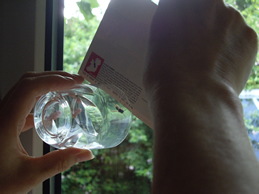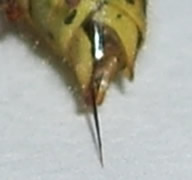You must always put your own health above that of a wasp. If a wasp lands on you wait for it to fly off or brush gently off with something like a small piece of paper (do not brush it with your hand).
If you are faced with a wasp don’t challenge it - it is far better for you to leave the area (e.g. car, kitchen, picnic area) until the wasp has gone. Do not run or thrash or swat. If there is only one wasp, then keep still and, when safe, move to shade or away from what is attracting the wasp. If stinging seems inevitable, then cover your face with hands or clothing or get face-down on the ground. If there are multiple wasps then your removal to safety is urgent.
If you use a spray to kill a wasp leave the room immediately after spraying because a dying wasp is prone to stinging. An apparently dead wasp may be only stunned. Stinging is one of its last powers. If you spray insecticide remember to remove food, cover fruit and protect pets and people from inhalation.
If you find what appears to be an old and seemingly inactive wasp nest do not disturb it until you have been able to observe it in warm weather. There may still be living wasps inside.
Removing a wasp from the house


Wasps fly to the light when sources of sweet food are covered. You need one source of light, preferably a window. Turn off electric lights. If you have two windows in the room close the curtains of one. You can trap a wasp by placing the open end of a small to medium sized glass tumbler over the insect and placing this firmly against the window. You can then slip something firm but thin like a postcard between the window and the glass. Keeping the glass firmly closed with the card you can then release the insect outside. Once released you should quickly leave the area, go back inside the house and close the door.
Is it a bee or a wasp - you can tell from the sting!

It is useful to know if it was a bee or a wasp because alllergy to bee stings is much less common than allergy to wasps. If there is a poison sac it was definitely a bee. If there is no poison sac on your skin- then it was probably a wasp - unless you have brushed the poison sac away without noticing.
With a bee sting the poison sac(k) will usually be left behind and the muscles around the sac continue to pump the poison (venom) into you. In such a case you need to scrape the sting and poison sac off as quickly as possible using anything readily to hand that would act in a similar way to a fingernail, credit card, piece of cardboard or blade of a blunt knife. Speed of removal is considered to be a higher priority than technique.
Allergy to bees is uncommon but you can treat a bee sting in much the same way as a wasp sting, omitting the brief topical vinegar stage.


